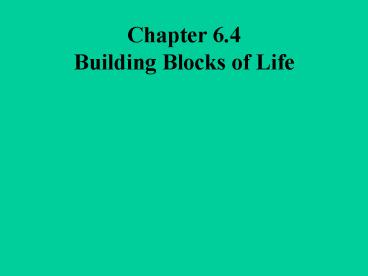Chapter 6.4 Building Blocks of Life - PowerPoint PPT Presentation
1 / 36
Title:
Chapter 6.4 Building Blocks of Life
Description:
Chapter 6.4 Building Blocks of Life RNA (1) Ribonucleic Acid (2) Makes a copy of DNA that is used to make proteins. Match the base pairs! – PowerPoint PPT presentation
Number of Views:117
Avg rating:3.0/5.0
Title: Chapter 6.4 Building Blocks of Life
1
Chapter 6.4Building Blocks of Life
2
I. Role of Carbon
- A. Carbon Bonding
- 1. C has four outer shell electrons (e-).
3
2. Carbon can form four covalent bonds.
4
3. When carbon atoms bond together they form
- a. Straight chains
5
b. Branched chains
6
c. Rings
7
4. Together, carbon compounds lead to the
diversity of life on Earth.
8
B. Macromolecules
- 1. Large molecules made
- of smaller units.
- 2. POLYMERS made of MONOMERS.
9
II. Types of Macromolecules(Polymers)
10
A. Carbohydrates
- 1. Composed of Carbon, Hydrogen and Oxygen with
a ratio of 1C2H1O.
11
2. Types of Carbohydrates
- a. Monosaccharides
- (1) Composed of one sugar.
- (2) Examples are glucose and fructose.
fructose
glucose
12
6H2O 6CO2 ----------gt C6H12O6 6O2
13
b. disaccharides
- (1) Composed of two sugars.
- (2) Examples are sucrose (table sugar).
14
c. Polysaccharides
- (1) These are polymers.
- (2) Largest Carbohydrates.
- (3) Example are
15
- (1) Glycogen
16
(2) Starch
17
(No Transcript)
18
(3) Cellulose
19
B. Lipids
- 1. Composed of large C-H bonds with less Oxygen
molecules than carbohydrates. - 2. Commonly called Fats and Oils.
20
a. Phospholipids
- Responsible for the structure and function of the
cell membrane - Hydrophobic which allows lipids to serve as
barriers in biological membranes
b. Steroids
- Include cholesterol and hormones
21
(No Transcript)
22
3. Used for
- (a) long term energy storage.
- (b) insulation.
- (c) protective coatings
- (d) cell membranes.
23
C. Proteins
- 1. Composed of C, H, O, N and usually S.
24
2. Basic building blocks of proteins are amino
acids.
- a. There are only 20 amino acids and they are
common to all living things. - b. Amino acids are linked together by peptide
bonds to form proteins.
25
3. Proteins are essential to ALL life.
26
Proteins are responsible for the following
- a. Provide structure for tissues and organs.
- b. Carry out cell metabolism.
- (1) Chemical reactions in an organism.
- (2) Enzymes- increase and decrease chemical
reactions. - c. Contract muscles.
- d. Transport oxygen in the blood.
- e. Provide immunity.
27
Nucleic Acids
- 1. Composed of C, H, O, N and P.
- 2. Elements are arranged in three groups.
- a. Base
- b. Sugar
- c. Phosphate group
28
The subunits are called NUCLEOTIDES.
29
Nucleic Acids store cellular information and form
a CODE.
30
Types of Nucleic Acids
31
DNA
- (1) Deoxyribonucleic Acid
- (2) The GENETIC CODE
32
Match the base pairs!DNA TO DNA
- AGGTCAGCCCATCCTT
- ???
33
Match the base pairs!DNA TO DNA
- AGGTCAGCCCATCCTT
- TCCAGTCGGGTAGGAA
34
RNA
- (1) Ribonucleic Acid
- (2) Makes a copy of DNA that is used to
make proteins.
35
Match the base pairs!DNA TO RNA
- AGGTCAGCCCATCCTT
- ???
36
Match the base pairs!RNA TO RNA
- AGGUCAGCCCAUCCUU
- ???































